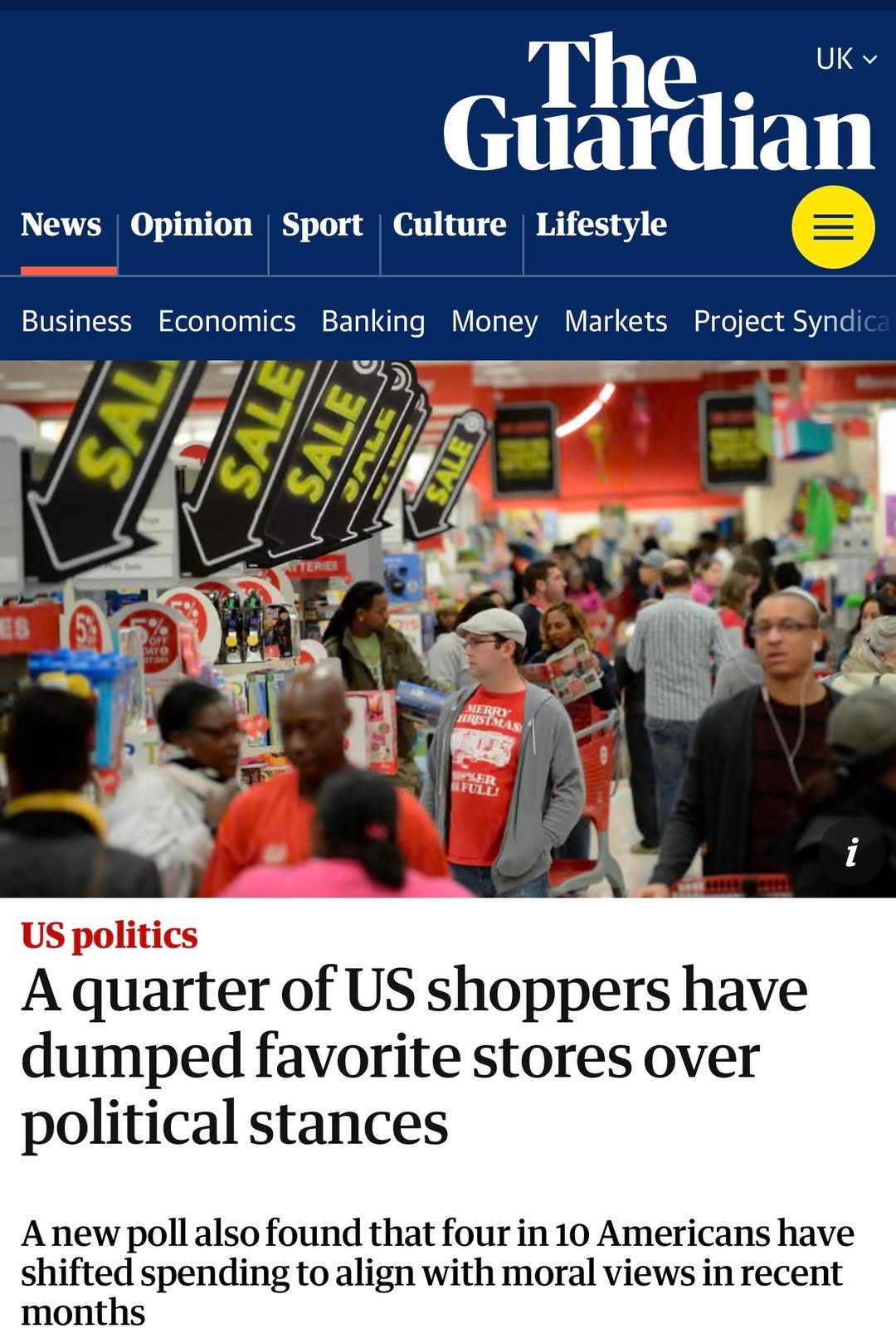The one-day "Economic Blackout" on February 28 started as a symbolic protest against corporate rollbacks of diversity, equity, and inclusion (DEI) initiatives, but its impact has extended far beyond a single day. What began as a simple call for consumers to withhold their spending from major retailers like Target and Walmart for 24 hours has the potential to fundamentally reshape shopping habits and flex new muscles beyond the ballot box at a time when Musk and Trump are trampling the checks and balances of democracy.
Immediate Impact on Retail Giants
The immediate impact was undeniable:
Target saw a steep drop in online traffic, with a 9% decline in website visitors and a 14% dip in app usage.
Walmart also took a hit, with website traffic down 5% and app engagement slipping by 2%.
Meanwhile, Costco—one of the few major retailers that has maintained its commitment to DEI—experienced the opposite effect, with a 22% surge in website visits and a noticeable uptick in app usage.
These numbers reflect more than just a one-day protest; they signify a shift in consumer priorities that continues to unfold weeks later.
A Shift in Consumer Behavior
What’s even more striking is how this action has triggered a deeper reassessment of where and how people shop. A recent survey revealed that a quarter of U.S. shoppers have abandoned their favorite stores over political stances. This isn't just about a single moment of outrage; it's about consumers recognizing the power of their wallets. Target’s very public capitulation on DEI policies was a breaking point for many, but the boycott energy hasn’t stopped there. Now, Amazon is squarely in the crosshairs, as more people choose to bypass corporate giants in favor of local businesses, farmer’s markets, and direct-to-consumer brands. The blackout was the spark, but the fire is being fueled by a growing awareness that every purchase is a political act.
I haven’t set foot in a big-box store in over three weeks, and Amazon hasn’t seen a dime from me either. I know I’m not alone. People are realizing that shifting their spending isn’t just an act of protest—it’s an opportunity to rediscover better products, better service, and a stronger sense of community. Additional boycott actions are being organizing including one harnessing Black spending power ( see targetfast.org) The blackout isn’t just a statement; it’s a wake-up call to corporations, politicians and to consumers who have forgotten the power of their wallet.
Lessons from History: Economic Activism as a Force for Change
Economic boycotts have reshaped societies before, and they continue to do so today. The Montgomery Bus Boycott of 1955-1956 lasted 381 days, far longer than many initially believed possible, despite the immense hardships endured by Black riders. As the boycott dragged on, the business community—restaurants, department stores, and other establishments dependent on foot traffic—began pressuring politicians to end the economic blockade. That relentless pressure, combined with legal action, eventually led to the Supreme Court ruling that desegregated public transportation.
Similarly, the Icelandic Women’s Strike of 1975 demonstrated the power of coordinated economic disruption. On October 24 of that year, 90% of Icelandic women refused to work, bringing the country to a standstill. Within a year, Iceland passed the Gender Equality Act, and by 1980, it elected the world's first female president. These actions show that economic resistance—whether sustained for over a year like Montgomery or concentrated into a single explosive day like in Iceland—has the power to force change.
The international boycott of South African goods during the anti-apartheid movement offers yet another example. Sustained economic pressure and sanctions from the global community played a pivotal role in dismantling apartheid. These historical precedents underscore that consumer activism isn’t just symbolic—it has real economic and political consequences.
History shows us that economic activism has long been a powerful tool for change. One of the most famous examples of economic activism is the Montgomery Bus Boycott of 1955-1956. Lasting 381 days, it cost the transit system the modern equivalent of $35,000 per day and ultimately led to a Supreme Court ruling that desegregated public transportation. This movement demonstrated the power of sustained economic pressure in forcing change.
The international boycott of South African goods during the anti-apartheid movement was another example of economic leverage used to dismantle oppressive systems. These historical precedents highlight that consumer activism is not just symbolic—it can have real economic and political consequences.
The Icelandic Women’s Strike of 1975 provides one of the clearest examples. On October 24 of that year, 90% of Icelandic women walked off the job and refused to do any unpaid labor, including childcare and housework, to protest gender inequality. The result? The country ground to a halt. Schools closed. Fish factories and airlines suspended operations. Men, suddenly responsible for childcare, overwhelmed supermarkets, causing an unexpected sausage shortage. But beyond the immediate disruption, the strike forced policy change—within a year, Iceland passed a Gender Equality Act, and by 1980, the country elected the world’s first female president. The strike also inspired decades of continued activism, with Icelandic women staging follow-up protests in subsequent years, gradually chipping away at the gender pay gap.
These moments in history remind us that economic resistance is one of the most effective ways to challenge entrenched power structures.
The Blackout’s Growing Reach and Global Economic Realignments
The February 28 Economic Blackout follows in that tradition, mirroring Iceland’s strategy of using one day to make inequality impossible to ignore. And this is happening against the backdrop of major global shifts in trade and economic alliances.
Americans are increasingly siding with Canada, which has responded to Trump’s tariffs with far more aggressive measures than originally assumed. Canadian leaders, recognizing the volatility of American trade policies, are repositioning their economy to rely less on U.S. imports and exports. In particular, Canada is targeting goods produced in Red states, where governors and legislatures have proven to be toothless lap dogs to Trump's agenda. By imposing tariffs and trade restrictions on industries rooted in these states, Canada is sending a clear message that economic consequences will follow political choices. American consumers, weary of price hikes and political instability, are showing new levels of support for Canadian products, reinforcing a shift that could permanently alter North American trade dynamics.
Meanwhile, Europe is rethinking its economic ties with the United States, no longer seeing it as a stable democratic ally but as a dangerous Russian asset. The European Union, alarmed by Trump’s policies and his growing alignment with authoritarian figures, is accelerating its own economic decoupling from the U.S. Trade agreements that once seemed unbreakable are now in question, and nations that previously depended on American leadership in global markets are seeking new partners. Trade, once thought of as immune to political turmoil, is being fundamentally reconfigured in real time.
While the financial losses in just one day may be temporary, the shift in consumer behavior is lasting. This movement has already created ripple effects—one Aldi location in Indianapolis reported a staggering 62% revenue drop during the blackout. As more groups extend the movement, retailers are being forced to reckon with the consequences of their choices.
And the fallout isn’t just limited to traditional retailers. Tesla is in freefall, caught in the crosshairs of consumer backlash, global sales declines, and investor revolt. Once the darling of the electric vehicle market, Tesla is now struggling under the weight of its CEO’s political destruction. Since the start of 2025, Tesla’s stock has plummeted 45%, hitting its lowest point since 2024. A single-day drop of 14% on March 10 erased $550 billion in market value, and investors are losing patience. Shareholders have begun openly challenging Elon Musk’s leadership, questioning whether he is more focused on his political ambitions than the company’s future.
Sales are cratering across the globe. In Europe, Tesla saw a 50% drop in January sales, with Germany down 70% and France declining 60% year-over-year. China’s February sales were nearly half of what they were in 2024, as domestic EV makers continue to erode Tesla’s market share. Even in the U.S., once Tesla’s strongest base, California dealerships report a sharp rise in Tesla trade-ins as consumers look for alternatives. Tesla’s brand image is collapsing. Long-time supporters—many of whom were drawn to Tesla for its climate-friendly mission—are dumping the brand, with protestors vandalizing Tesla showrooms and labeling vehicles as “Swasticars.” Used Tesla prices have fallen so sharply that many sellers are absorbing $10,000 losses, while some owners are going as far as rebadging their Teslas with Audi or Toyota logos to distance themselves from Musk’s increasingly toxic image.
The Future of Consumer-Led Change
The message from the blackout is that people are increasingly aware of their economic power and may be willing to use it to hold companies accountable. History has shown, when consumers move with purpose, they are a force that cannot be ignored.







Thank you for writing this! I have been boycotting Amazon and Target and wondering if it was having any impact. Great news!
We have also canceled Target card, and Amazon Prime, given up Starbucks and Amazon. We're trying to use the IGAs as much as possible but it's expensive. No Walmart shopping for us either.